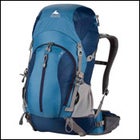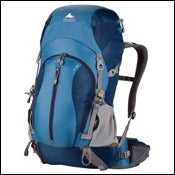Many years ago, I had daypack made by a then-renowned maker that in this case shall remain nameless. It was a nice pack—roomy, carried well. I went up many a Northwest peak with it. Its back pad consisted of wool felt. That’s right. Wool felt. It was like strapping a warm ewe to your back and hiking uphill for four years. Just miserable. And not even very safe. A quick break on a chilly day, and my back iced up in minutes.
 The Z35
The Z35Things are much better today, but nothing is perfect. It’s difficult to get perfect airflow between back and pack, but makers are doing some interesting things. Take a look at ‘s Z35 ($150), a 2,200-cubic-inch capacity pack that has a great suspension, can carry 25 to 30 pounds nicely, and has a design that holds the pack off your back and puts a mesh panel between it and you. So breathability is very good. I have one and like it a lot.
I also like ‘s Matterhorn 30 ($139). It uses a molded back panel that has air “channels” that help keep air flowing over your back. Very nice. Just a bit smaller than the Gregory, but also designed more for climbing, with extra loops and stuff for holding ice tools, ropes, and so on. But a nice daypack.
And…thereÂ’s the Stratos 40 ($150). Osprey makes really great packs—well designed, light, and sturdy. The Stratos has two fiberglass struts that help support a heavy load while keeping the pack off your back, and a mesh panel stretched between the struts helps promote airflow. Very nice.
Of course, it helps to dress so that you can get dry quickly when you’ve been working. I like ‘s Capilene 1 ($40 in long-sleeve crew), a superlight but versatile base layer that is great when you’re blowing out calories, and it dries in a flash. A great hiking base layer.


